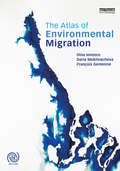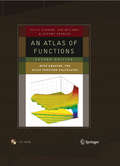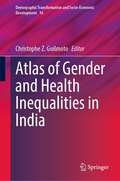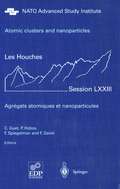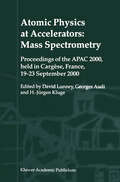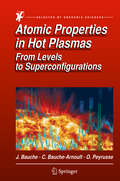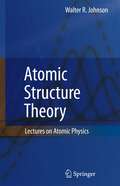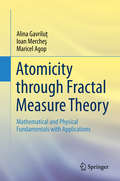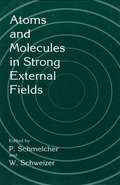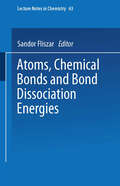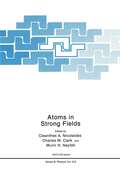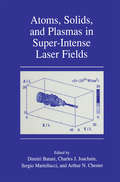- Table View
- List View
Atiyah-Singer Index Theorem - An Introduction: An Introduction (Texts and Readings in Mathematics)
by Amiya MukherjeeAtlas of Cancer Mortality in Poland 1975–1979
by Witold Zatonski Nikolaus BeckerThe first publication of cancer mortality data in Po ners, research workers and political authorities for land took place 100 years ago in 1888. The evalua information on frequencies, time trends, and spatial tion of such data was greatly enhanced in the early distributions of the different cancer sites. 1960s when the Polish Cancer Registry was estab Secondly, it may promote epidemiological research lished at the Maria Sldodowska-Curie Memorial on causal factors determining cancer occurrence in Cancer Institute in Warszawa. Data from this regis Poland. In this connection, it has to be kept in mind try and their epidemiological analysis provided the that the presentation of geographical distribution of basis for planning cancer control in Poland. The diseases cannot by itself provide evidence for any National Cancer Programme permitted a develop speculations on causal relationships. Cancer map ment of comprehensive cancer centres and cancer ping offers a valuable basis for obtaining new in research. sights and creating new hypotheses. The proof will Differences in cancer incidence and mortality ob have to be left to the more refined research meth served in various regions of Poland have been eval ods of modem epidemiology, which is also pursued uated during the past two decades using data col at our institutes.
The Atlas of Environmental Migration
by Dina Ionesco Daria Mokhnacheva François GemenneAs climate change and extreme weather events increasingly threaten traditional landscapes and livelihoods of entire communities the need to study its impact on human migration and population displacement has never been greater. The Atlas of Environmental Migration is the first illustrated publication mapping this complex phenomenon. It clarifies terminology and concepts, draws a typology of migration related to environment and climate change, describes the multiple factors at play, explains the challenges, and highlights the opportunities related to this phenomenon. Through elaborate maps, diagrams, illustrations, case studies from all over the world based on the most updated international research findings, the Atlas guides the reader from the roots of environmental migration through to governance. In addition to the primary audience of students and scholars of environment studies, climate change, geography and migration it will also be of interest to researchers and students in politics, economics and international relations departments.
The Atlas of Environmental Migration
by Dina Ionesco Daria Mokhnacheva François GemenneAs climate change and extreme weather events increasingly threaten traditional landscapes and livelihoods of entire communities the need to study its impact on human migration and population displacement has never been greater. The Atlas of Environmental Migration is the first illustrated publication mapping this complex phenomenon. It clarifies terminology and concepts, draws a typology of migration related to environment and climate change, describes the multiple factors at play, explains the challenges, and highlights the opportunities related to this phenomenon. Through elaborate maps, diagrams, illustrations, case studies from all over the world based on the most updated international research findings, the Atlas guides the reader from the roots of environmental migration through to governance. In addition to the primary audience of students and scholars of environment studies, climate change, geography and migration it will also be of interest to researchers and students in politics, economics and international relations departments.
An Atlas of Functions: with Equator, the Atlas Function Calculator
by Keith B. Oldham Jerome Spanier Jan MylandThis book comprehensively covers several hundred functions or function families. In chapters that progress by degree of complexity, it starts with simple, integer-valued functions then moves on to polynomials, Bessel, hypergeometric and hundreds more.
Atlas of Gender and Health Inequalities in India (Demographic Transformation and Socio-Economic Development #16)
by Christophe Z. GuilmotoHow will the world's largest population approach its inequality challenges? This volume addresses this question by unraveling different strands of India's emerging health and gender geographies. It is the first book to offer a comparative study of these disparities in India, stressing the deep interaction between health challenges and patriarchal features. Most themes explored in this book illustrate the entangled nature of the social and regional determinants of gender and health imbalances in India. Through its rich cartography of contemporary India, the book represents the first Atlas exploiting district-level figures drawn from the latest sociodemographic survey conducted in 2019-21. After an initial methodological synopsis, the book is built around twenty chapters—illustrated by 75 original maps, figures, and tables prepared by thirty authors—and concludes with a synthesis of India's spatial patterns. Chapters engage with major themes of gender and health inequalities and explore an array of innovative indicators such as access to menstrual hygiene, cesarean deliveries, health insurance, son preference in fertility, female landownership, patrilocal systems, hypertension, anemia, hysterectomy, girl-only or single-child families, or traditional contraception. Together, they provide an often surprising glimpse into the present and future of India's gender and health landscape, highlighting the considerable progress accomplished over the last two decades alongside persistent gaps and emerging issues.
The Atlas of Social Complexity
by Brian Castellani Lasse GerritsEmbark on a riveting journey through the study of social complexity with The Atlas of Social Complexity. Over three decades of scientific exploration unfold, unravelling the enigmatic threads that compose the fabric of society. From the dance of bacteria, to human-machine interactions, to the ever-shifting dynamics of power in social networks, this Atlas maps the evolution of our understanding of social complexity.Brian Castellani’s and Lasse Gerrits’ Atlas is not merely retrospective. It is a compass pointing to uncharted territories: new directions for research and intellectual debate. With wit and insight, they invite the reader to ponder unanswered questions, taking them on a quest for alternative ways to understand the intricate complexities of societies.The Atlas of Social Complexity is a thrilling expedition into the heart of what makes us human: from cognition, emotion, consciousness, the dynamics of human psychology, to social networks, collective behaviour, politics and governance, technology and planning, and the practice of social interventions. The Atlas also visits cross-cutting themes such as intersectionality, configurational complexity, and research methods.Organised around six transdisciplinary themes and twenty-four topics the Atlas is an invaluable resource for all social science and complexity science scholars and students interested in new ideas and new ways of working in social complexity. It paves the way for the next generation of research in the study of social complexity.
Atmospheres and Oceans on Computers: Fundamental Numerical Methods for Geophysical Fluid Dynamics (Springer Textbooks in Earth Sciences, Geography and Environment)
by Lars Petter RøedThis textbook introduces step by step the basic numerical methods to solve the equations governing the motion of the atmosphere and ocean, and describes how to develop a set of corresponding instructions for the computer as part of a code. Today's computers are powerful enough to allow 7-day forecasts within hours, and modern teaching of the subject requires a combination of theoretical and computational approaches. The presentation is aimed at beginning graduate students intending to become forecasters or researchers, that is, users of existing models or model developers. However, model developers must be well versed in the underlying physics as well as in numerical methods. Thus, while some of the topics discussed in the modeling of the atmosphere and ocean are more advanced, the book ensures that the gap between those scientists who analyze results from model simulations and observations and those who work with the inner works of the model does not widen further. In this spirit, the course presents methods whereby important balance equations in oceanography and meteorology, namely the advection-diffusion equation and the shallow water equations on a rotating Earth, can be solved by numerical means with little prior knowledge. The numerical focus is on the finite-difference (FD) methods, and although more powerful methods exist, the simplicity of FD makes it ideal as a pedagogical introduction to the subject. The book also includes suitable exercises and computer problems.
Atmospheric and Space Flight Dynamics: Modeling and Simulation with MATLAB® and Simulink® (Modeling and Simulation in Science, Engineering and Technology)
by Ashish TewariThis book offers a unified presentation that does not discriminate between atmospheric and space flight. It demonstrates that the two disciplines have evolved from the same set of physical principles and introduces a broad range of critical concepts in an accessible, yet mathematically rigorous presentation. The book presents many MATLAB and Simulink-based numerical examples and real-world simulations. Replete with illustrations, end-of-chapter exercises, and selected solutions, the work is primarily useful as a textbook for advanced undergraduate and beginning graduate-level students.
Atmospheric Circulation Dynamics and General Circulation Models (Springer Praxis Books)
by Masaki SatohGeneral circulation models (GCMs), which define the fundamental dynamics of atmospheric circulation, are nowadays used in various fields of atmospheric science such as weather forecasting, climate predictions and environmental estimations. The Second Edition of this renowned work has been updated to include recent progress of high resolution global modeling. It also contains for the first time aspects of high-resolution global non-hydrostatic models that the author has been studying since the publication of the first edition. Some highlighted results from the Non-hydrostatic ICosahedral Atmospheric Model (NICAM) are also included. The author outlines the theoretical concepts, simple models and numerical methods for modeling the general circulation of the atmosphere. Concentrating on the physical mechanisms responsible for the development of large-scale circulation of the atmosphere, the book offers comprehensive coverage of an important and rapidly developing technique used in the atmospheric science. Dynamic interpretations of the atmospheric structure and their aspects in the general circulation model are described step by step.
Atmospheric Research From Different Perspectives: Bridging the Gap Between Natural and Social Sciences (The Reacting Atmosphere #1)
by Ralf KoppmannThe book, the first in a series arising from the research network The Reacting Atmosphere, explains and outlines the aims of this ambitious cross-disciplinary effort. The central topic is air quality and climate change, and the methods of atmospheric physics and chemistry, applied mathematics and socio-economic science are used to advance the understanding of the role of the atmosphere in global change.
Atom- und Quantentheorie: II. Quantentheorie (Mathematisch-physikalische Bibliothek)
by P. KirchbergerDieser Buchtitel ist Teil des Digitalisierungsprojekts Springer Book Archives mit Publikationen, die seit den Anfängen des Verlags von 1842 erschienen sind. Der Verlag stellt mit diesem Archiv Quellen für die historische wie auch die disziplingeschichtliche Forschung zur Verfügung, die jeweils im historischen Kontext betrachtet werden müssen. Dieser Titel erschien in der Zeit vor 1945 und wird daher in seiner zeittypischen politisch-ideologischen Ausrichtung vom Verlag nicht beworben.
Atomic clusters and nanoparticles. Agregats atomiques et nanoparticules: Les Houches Session LXXIII 2-28 July 2000 (Les Houches - Ecole d'Ete de Physique Theorique #73)
by C. Guet P. Hobza F. Spiegelman F. DavidFocused on basic science, this book reviews experiments on metal clusters in two long pedagogically written articles. Interested readers will also find articles ranging from density functional theory to computer simulations of cluster dynamics.
Atomic Physics at Accelerators: Proceedings of the APAC 2000, held in Cargèse, France, 19–23 September 2000
by David Lunney Georges Audi Heinz-Jürgen KlugeThe search for examples of proton radioactivity has resulted in the discovery of a large number of proton emitters in the region 50 < Z < 84 [1]. Many of these proton emitters and their daughters are also a-emitters, and in some cases the a-decay chain from the daughter terminates on a nuclide closer to stability whose mass excess is known. This opens up the possibility of using a-and proton-decay Q-values to determine the mass excesses of a large group of nuclei connected by particle decay. The Q-values are derived from the measured kinetic energies of the emitted protons or a-particles. Where the decay chains are not connected to nuclei with known mass excesses, proton separation energies can be measured in some cases and derived in others. For the a-decay ofthe parent nucleus (Z, A) to the daughter (Z - 2, A - 4), the energy and momentum relations used to convert between Q-value, mass (M) and mass excess (ME) are: M(4He)E", (1) M(Z - 2, A - 4)Erecoil, (2) Q", E", + Erecoi\, ME(Z, A) Q", + ME(Z - 2, A - 4) + ME(4He). (3) In practice, one uses M(4He) ~ 4 and M(Z - 2, A - 4) (A - 4), so that Equation (3) becomes ME(Z, A) = E", (_A_) + ME(Z - 2, A - 4) + ME(4He). (4) A -4 Similarly, for protons, we have ME(Z, A) = Ep(_A_) +ME(Z - 1, A-I) +ME(lH).
Atomic Properties in Hot Plasmas: From Levels to Superconfigurations
by Jacques Bauche Claire Bauche-Arnoult Olivier PeyrusseThis book is devoted to the calculation of hot-plasma properties which generally requires a huge number of atomic data. It is the first book that combines information on the details of the basic atomic physics and its application to atomic spectroscopy with the use of the relevant statistical approaches. Information like energy levels, radiative rates, collisional and radiative cross-sections, etc., must be included in equilibrium or non-equilibrium models in order to describe both the atomic-population kinetics and the radiative properties. From the very large number of levels and transitions involved in complex ions, some statistical (global) properties emerge. The book presents a coherent set of concepts and compact formulas suitable for tractable and accurate calculations. The topics addressed are: radiative emission and absorption, and a dozen of other collisional and radiative processes; transition arrays between level ensembles (configurations, superconfigurations); effective temperatures of configurations, superconfigurations, and ions; charge-state distributions; radiative power losses and opacity. There are many numerical examples and comparisons with experiment presented throughout the book. The plasma properties described in this book are especially relevant to large nuclear fusion facilities such as the NIF (California) and the ITER (France), and to astrophysics.Methods relevant to the central-field configurational model are described in detail in the appendices: tensor-operator techniques, second-quantization formalism, statistical distribution moments, and the algebra of partition functions. Some extra tools are propensity laws, correlations, and fractals. These methods are applied to the analytical derivation of many properties, specially the global ones, through which the complexity is much reduced. The book is intended for graduate-level students, and for physicists working in the field.
Atomic Structure Theory: Lectures on Atomic Physics
by Walter R. JohnsonThis book provides a hands-on experience with atomic structure calculations. Material covered includes angular momentum methods, the central field Schrödinger and Dirac equations, Hartree-Fock and Dirac-Hartree-Fock equations, multiplet structure, hyperfine structure, the isotope shift, dipole and multipole transitions, basic many-body perturbation theory, configuration interaction, and correlation corrections to matrix elements. The book also contains numerical methods for solving the Schrödinger and Dirac eigenvalue problems and the (Dirac)-Hartree-Fock equations.
Atomicity through Fractal Measure Theory: Mathematical and Physical Fundamentals with Applications
by Alina Gavriluţ Ioan Mercheş Maricel AgopThis book presents an exhaustive study of atomicity from a mathematics perspective in the framework of multi-valued non-additive measure theory. Applications to quantum physics and, more generally, to the fractal theory of the motion, are highlighted. The study details the atomicity problem through key concepts, such as the atom/pseudoatom, atomic/nonatomic measures, and different types of non-additive set-valued multifunctions. Additionally, applications of these concepts are brought to light in the study of the dynamics of complex systems.The first chapter prepares the basics for the next chapters. In the last chapter, applications of atomicity in quantum physics are developed and new concepts, such as the fractal atom are introduced. The mathematical perspective is presented first and the discussion moves on to connect measure theory and quantum physics through quantum measure theory. New avenues of research, such as fractal/multifractal measure theory with potential applications in life sciences, are opened.
Atomistic Computer Simulations: A Practical Guide
by Veronika Brázdová David R. BowlerMany books explain the theory of atomistic computer simulations; this book teaches you how to run them This introductory "how to" title enables readers to understand, plan, run, and analyze their own independent atomistic simulations, and decide which method to use and which questions to ask in their research project. It is written in a clear and precise language, focusing on a thorough understanding of the concepts behind the equations and how these are used in the simulations. As a result, readers will learn how to design the computational model and which parameters of the simulations are essential, as well as being able to assess whether the results are correct, find and correct errors, and extract the relevant information from the results. Finally, they will know which information needs to be included in their publications. This book includes checklists for planning projects, analyzing output files, and for troubleshooting, as well as pseudo keywords and case studies. The authors provide an accompanying blog for the book with worked examples, and additional material and references: http://www.atomisticsimulations.org/.
Atomistic Computer Simulations: A Practical Guide
by Veronika Brázdová David R. BowlerMany books explain the theory of atomistic computer simulations; this book teaches you how to run them This introductory "how to" title enables readers to understand, plan, run, and analyze their own independent atomistic simulations, and decide which method to use and which questions to ask in their research project. It is written in a clear and precise language, focusing on a thorough understanding of the concepts behind the equations and how these are used in the simulations. As a result, readers will learn how to design the computational model and which parameters of the simulations are essential, as well as being able to assess whether the results are correct, find and correct errors, and extract the relevant information from the results. Finally, they will know which information needs to be included in their publications. This book includes checklists for planning projects, analyzing output files, and for troubleshooting, as well as pseudo keywords and case studies. The authors provide an accompanying blog for the book with worked examples, and additional material and references: http://www.atomisticsimulations.org/.
Atoms and Molecules in Strong External Fields
by P. Schmelcher W. SchweizerThis book contains contributions to the 172. WE-Heraeus-Seminar “Atoms and Molecules in Strong External Fields,” which took place April 7–11 1997 at the Phys- zentrum Bad Honnef (Germany). The designation “strong fields” applies to external static magnetic, and/or electric fields that are sufficiently intense to cause alterations in the atomic or molecular str- ture and dynamics. The specific topics treated are the behavior and properties of atoms in strong static fields, the fundamental aspects and electronic structure of molecules in strong magnetic fields, the dynamics and aspects of chaos in highly excited R- berg atoms in external fields, matter in the atmosphere of astrophysical objects (white dwarfs, neutron stars), and quantum nanostructures in strong magnetic fields. It is obvious that the elaboration of the corresponding properties in these regimes causes the greatest difficulties, and is incomplete even today. Present-day technology has made it possible for many research groups to study the behavior of matter in strong external fields, both experimentally and theore- cally, where the phrase “experimentally” includes the astronomical observations. - derstanding these systems requires the development of modern theories and powerful computational techniques. Interdisciplinary collaborations will be helpful and useful in developing more efficient methods to understand these important systems. Hence the idea was to bring together people from different fields like atomic and molecular physics, theoretical chemistry, astrophysics and all those colleagues interested in aspects of few-body systems in external fields.
Atoms, Chemical Bonds and Bond Dissociation Energies (Lecture Notes in Chemistry #63)
by Sandor FliszarChemical bonds, their intrinsic energies in ground-state molecules and the energies required for their actual cleavage are the subject of this book. The theory, modelled after a description of valence electrons in isolated atoms, explains how intrinsic bond energies depend on the amount of electronic charge carried by the bond-forming atoms. It also explains how bond dissociation depends on these charges. While this theory vividly explains thermochemical stability, future research could benefit from a better understanding of bond dissociation: if we learn how the environment of a molecule affects its charges, we also learn how it modifies bond dissociation in that molecule. This essay is aimed at theoretical and physical-organic chemists who are looking for new perspectives to old problems.
Atoms in Strong Fields (Nato Science Series B: #212)
by Efthymios Nicolaidis Charles W. Clark Munir H. NayfehThis book collects the lectures given at the NATO Advanced Study Institute on "Atoms in Strong Fields", which took place on the island of Kos, Greece, during the two weeks of October 9-21,1988. The designation "strong field" applies here to an external electromagnetic field that is sufficiently strong to cause highly nonlinear alterations in atomic or molecular struc ture and dynamics. The specific topics treated in this volume fall into two general cater gories, which are those for which strong field effects can be studied in detail in terrestrial laboratories: the dynamics of excited states in static or quasi-static electric and magnetic fields; and the interaction of atoms and molecules with intense laser radiation. In both areas there exist promising opportunities for research of a fundamental nature. An electric field of even a few volts per centimeter can be very strong on the atom ic scale, if it acts upon a weakly bound state. The study of Rydberg states with high reso lution laser spectroscopic techniques has made it possible to follow the transition from weak-field to strong-field behavior in remarkable detail, using static fields of modest lab oratory strength; in the course of this transition the atomic system evolves from one which can be thoroughly understood in terms of field-free quantum numbers, to one which cannot be meaningfully associated at all with the zero-field states of the atom.
Atoms, Solids, and Plasmas in Super-Intense Laser Fields
by Dimitri Batani Charles J. Joachain S. Martellucci Arthur N. ChesterThe recent developement of high power lasers, delivering femtosecond pulses of 20 2 intensities up to 10 W/cm , has led to the discovery of new phenomena in laser interactions with matter. At these enormous laser intensities, atoms, and molecules are exposed to extreme conditions and new phenomena occur, such as the very rapid multi photon ionization of atomic systems, the emission by these systems of very high order harmonics of the exciting laser light, the Coulomb explosion of molecules, and the acceleration of electrons close to the velocity of light. These phenomena generate new behaviour of bulk matter in intense laser fields, with great potential for wide ranging applications which include the study of ultra-fast processes, the development of high-frequency lasers, and the investigation of the properties of plasmas and condensed matter under extreme conditions of temperature and pressure. In particular, the concept of the "fast ignitor" approach to inertial confinement fusion (ICF) has been proposed, which is based on the separation of the compression and the ignition phases in laser-driven ICF. The aim of this course on "Atom, Solids and Plasmas in Super-Intense Laser fields" was to bring together senior researchers and students in atomic and molecular physics, laser physics, condensed matter and plasma physics, in order to review recent developments in high-intensity laser-matter interactions. The course was held at the Ettore Majorana International Centre for Scientific Culture in Erice from July 8 to July 14,2000.
Attacks, Defenses and Testing for Deep Learning
by Jinyin Chen Ximin Zhang Haibin ZhengThis book provides a systematic study on the security of deep learning. With its powerful learning ability, deep learning is widely used in CV, FL, GNN, RL, and other scenarios. However, during the process of application, researchers have revealed that deep learning is vulnerable to malicious attacks, which will lead to unpredictable consequences. Take autonomous driving as an example, there were more than 12 serious autonomous driving accidents in the world in 2018, including Uber, Tesla and other high technological enterprises. Drawing on the reviewed literature, we need to discover vulnerabilities in deep learning through attacks, reinforce its defense, and test model performance to ensure its robustness. Attacks can be divided into adversarial attacks and poisoning attacks. Adversarial attacks occur during the model testing phase, where the attacker obtains adversarial examples by adding small perturbations. Poisoning attacks occur during the model training phase, wherethe attacker injects poisoned examples into the training dataset, embedding a backdoor trigger in the trained deep learning model. An effective defense method is an important guarantee for the application of deep learning. The existing defense methods are divided into three types, including the data modification defense method, model modification defense method, and network add-on method. The data modification defense method performs adversarial defense by fine-tuning the input data. The model modification defense method adjusts the model framework to achieve the effect of defending against attacks. The network add-on method prevents the adversarial examples by training the adversarial example detector. Testing deep neural networks is an effective method to measure the security and robustness of deep learning models. Through test evaluation, security vulnerabilities and weaknesses in deep neural networks can be identified. By identifying and fixing these vulnerabilities, the security and robustness of the model can be improved. Our audience includes researchers in the field of deep learning security, as well as software development engineers specializing in deep learning.



